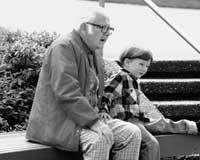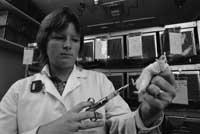New steps against Alzheimer’s disease
1999/09/01 Kortabarria Olabarria, Beñardo - Elhuyar Zientzia Iturria: Elhuyar aldizkaria

Alzheimer's disease is the most widespread demential disease among older people, since about half of all dementias are Alzheimer's disease. It is believed that today in the world there are 22 million people suffering from Alzheimer's disease and, if no cure is detected in the short term, it can double in 30 years. According to all the studies being carried out, 10% of those over 65 years in the world develop Alzheimer's disease and 47% of those over 85 years of age. Euskal Herria is no exception, since Alzheimer's disease makes no difference between countries or races, because here too the global means are repeated. In Euskal Herria there are about 35,000 people with Alzheimer's disease.
What is Alzheimer's disease?
The disease identified by researcher Alois Alzheimer in 1907 is, from a scientific point of view, a degenerative and progressive brain dementia. The immediate loss of memory is due to the deterioration of the neurons of the memory and the neurons responsible for the ability to think, with which the communication between the neurons is interrupted. The skin of the brain of Alzheimer's patients, the main source of intellectual function, is degenerate and contractile, creating gaps in the center of the brain.
Alzheimer's patients feel lost, lose the sense of time and place, suffer a change of personality, sudden changes of sense, difficulty finding words, ideas or thoughts, can not continue to command and, finally, are not able to take care of themselves. The disease process, from diagnosis to death, can last between 2 and 20 years. The process can be summarized as follows:
- First phase
It can last between 2 and 5 years. The patient loses the memory clearly: he can forget that he has already eaten, does not know the places or the way to get to the places, he can confuse the schedule and there are changes of humor that suddenly happen from depression to happiness. The ability to speak, perception, and motor skills are fine.
- Second phase
It can last between 2 and 10 years. All aspects of memory begin to fail and symptoms of dyspasia, apraxia, and agnosis appear. Afasia is a difficulty speaking. The patient has trouble speaking correctly. For his part, Apraxia is the difficulty to do things that the sick man does mechanically until then, like dressing. Finally, agnosia, ignorance of the environment, lack of cleaning and immersion in psychotic situations. Symptoms of Parkinson's disease can also appear, such as sudden movements of hands and legs, uncontrolled, etc.
- Third phase

All the necessary functions are lost for the mind to work, the ability to move the muscles is lost, earthquakes and epileptic seizures appear. The patient does not know his family members, is placed in front of the mirror and is unknown… the personality is lost. Apathy predominates, they are not able to wash, dress, walk, or feed. Later they remain unable to retain urine and cocoa. They end up in bed until they are killed by some pneumonia or virus infection.
Although the disease process is known, the causes are not known. It is evident that the brothers and children of Alzheimer's patients have a certain tendency to develop the disease, but this does not mean that the disease develops by inheritance. Only 10% of Alzheimer's patients are hereditary, at least three in the same family. In addition to genetic agents, to know the causes of the disease, agents of the environment, viruses, electromagnetic fields, etc are being investigated.
Is there any treatment?
It remains to be seen the impact that the vaccine that has been successful in the mouse can have on humans, but so far this disease has had no remedy. However, there are treatments that can help improve the situation, such as drugs to avoid the rapid deterioration of acetylcholine, essential for brain and cell communication. However, according to experts, the best drug is love, patience and understanding of the behavior of patients.
In any case, the discoveries announced by scientists of the American company Elan Corporation in early July in the journal Nature can change the environment of Alzheimer's disease. The vaccine will not cure the disease, but if, by testing it with humans, results similar to those obtained with mice were extracted, Alzheimer would already have treatment, it would not be possible to cure the disease, but paralysis. On the other hand, if the vaccine was effective in prevention, the extinction of the disease would occur. Therefore, the calculations of experts for the future would be bankrupt. However, it will take long to do so, as there is still no permission to test the vaccine in humans, who expect to get permission and start this year.
What is the vaccine based on?

One of the most prominent features of Alzheimer's disease is the concentration of the protein called amyloid that occurs in the brain. The mice used in laboratory tests were genetically modified to produce more amyloids than are common in the brain. The AN-1792 vaccine prevented the creation of amyloid plaques. According to researcher Ivan Lieberburg of Elan Corporation, the amyloid plate was considered an invading agent. "We wanted to see the amyloids like any invader, like a bacterium, and that's why we were looking for the vaccine".The researchers at Elan Corporation tried to deceive the immune system of the mice so that the system itself considered the amyloids as agile substances. For this purpose, nine amyloid mice were injected, combined with other elements, which did not receive the vaccine, 17. After 13 months the brains of mice were analyzed and the absence or shortage of amyloids was observed in the brains of the vaccinated mice; in the rest of mice the amyloid concentration was high. A second trial was also carried out, by delivering the vaccine to mice with numerous amyloid plaques. "The vaccine paralyzed the development of the disease and, apparently, decreased the concentration of plaques."
Although trials with mice open a gap for hope, there are reasons that can make it think that the vaccine may have no value in the human being to fight Alzheimer's disease. One of them, the most basic, are amyloids, since the amyloid concentration can be symptom of the disease and not cause it. On the other hand, Alzheimer's patients have other characteristics that mice do not have in the brain. Finally, it is not clear whether all the symptoms and behaviors mentioned above are a consequence of the onset of Alzheimer's disease or can be a consequence of another type, so to achieve total success it would be necessary to know clearly in advance who has the disease and who is at risk of suffering it.
Although it will take time to know whether or not it serves to fight Alzheimer's disease, the AN-1972 vaccine opens up new possibilities to fight against diseases derived from protein concentrations such as Creutzfeldt-Jakob disease, closely related to mad cow disease, or Parkinson's disease.

Gai honi buruzko eduki gehiago
Elhuyarrek garatutako teknologia




